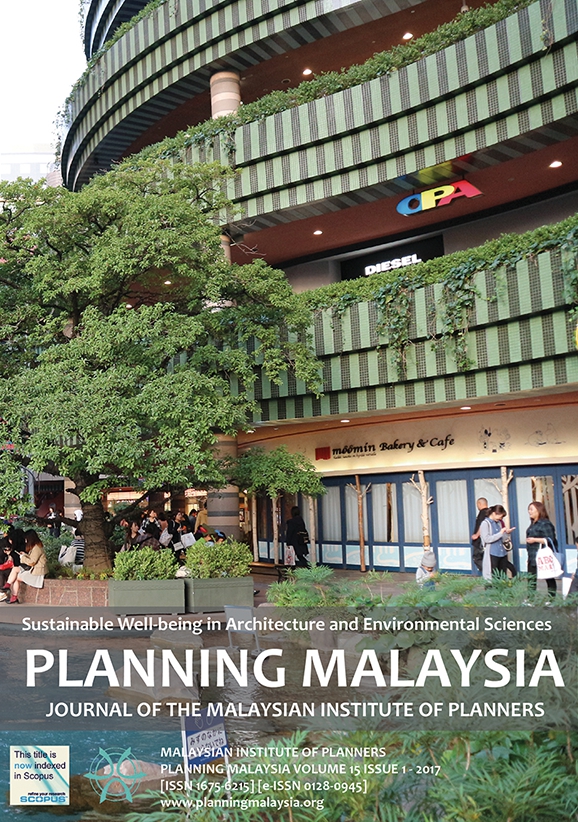CONTENT ANALYSIS OF THE EXISTENCE OF BIOMIMICRY LIFES PRINCIPLES IN GREEN BUILDING INDEX MALAYSIA
DOI:
https://doi.org/10.21837/pm.v15i1.233Keywords:
Green Building Index (GBI), Biomimicry - Life’s Principles (BLP), content analysis, presence, extent of presenceAbstract
Concerns about climate change and global warming have led many countries to initiate energy rating systems in the planning and development of the built environment. Although useful and novel, this paper contends that these ratings are only remedying and alleviating whatever negative impacts that development creates. Energy ratings are seemingly lacking in attempts to integrate and enhance the physical development of the natural environment. Instead, biomimicry is adiscipline that explores nature and tries to understand its bio-integration for the establishment of sustainable products, processes and systems. This paper postulates that with the integration of Biomimicry – Life’s Principles (BLP) into the Green Building Index (GBI) Malaysia, a higher level of environmental sustainability could be achieved. This paper attempted to explore the presence
and the extent of the presence of BLP in the existing GBI utilizing the content analysis method. This article concludes that although the presence of BLP in the GBI is high, the extent of the presence is low. The paper also recommends the areas of concern that could be improved within the GBI for a more effective rating system.
Downloads
References
Baumeister, D. (2012). Biomimicry resource handbook, life’s principles, and biomimicry spirals. Missoula MT, USA: Biomimicry Group Inc.
Benyus, J. (1997). Biomimicry: innovation inspired by nature. New York, USA: William Morrow & Company, Inc.
Biomimicry 3.8. (2013). Biomimicry Design Lens: A visual guide. USA.
El Ahmar, S., Fioravanti, A., & Hanafi, M. (2013). A methodology for computational architectural design based on biological principles. In eCAADe 2013: Computation and Performance - Proceedings of the 31st International Conference on Education and research in Computer Aided Architectural Design in Europe. Delft: Faculty of Architecture, University of Delft.
El-Zeiny, R. M. A. (2012). Biomimicry as a problem solving methodology in interior architecture. Procedia - Social and Behavioral Sciences, 50, 502-512.
Elo, S., & Kynga, H. (2007). The qualitative content analysis process. Journal of Advanced Nursing, 62, 107-115.
Gamage, A., & Hyde, R. (2012). A model based on Biomimicry to enhance ecologically sustainable design. Architectural Science Review, 55(3), 224-235.
Kibert, C. J. (2012). Sustainable Construction: Green Building Design and Delivery (3rd ed.). Canada: John Wiley & Sons.
Klein, L. (2009). A phenomenological interpretation of Biomimicry and its potential value for sustainable design. (Doctoral dissertation) Kansas State University.
McGovern, J. (2009). Biomimicry: how learning from nature can restore sustainability in architecture. (Master’s dissertation) University of Cincinnati.
Non-Residential New Construction (NRNC) (2011). Retrieved on June 25, 2014 from: http://www.greenbuildingindex.org/Resources/GBI%20Tools/
Reap, J. J. (2009). Holistic biomimicry: A biologically inspired approach to environmentally benign engineering. (Doctoral dissertation) Georgia Institute of Technology, Ann Arbor.
Yeang, K., (2006). Ecodesign: a manual for ecological design. London: Wiley-Academy.
Zanowick, M. B. (2011). Biomimicry: Nature’s Time-Tested Framework for Sustainability. Retrieved from peakstoprairies.org/library/.../2012.../Biomimicry_overview_01_12.doc
Zari, M. (2015). Mimicking ecosystems for bio-inspired intelligent urban built environments. Intelligent Buildings International, 8(2), 57-77.
Zari, M. & Storey, J.B. (2007). An ecosystem based biomimetic theory for a regenerative built environment. In Proceedings of SB07: Sustainable Construction, Materials and Practices: Challenge of the Industry for the New Millennium. Lisbon, Portugal.
Downloads
Published
How to Cite
Issue
Section
License
Copyright & Creative Commons Licence
eISSN: 0128-0945 © Year. The Authors. Published for Malaysia Institute of Planners. This is an open-access article under the CC BY-NC-ND license.
The authors hold the copyright without restrictions and also retain publishing rights without restrictions.


